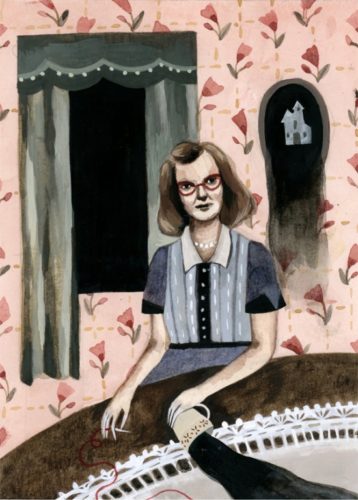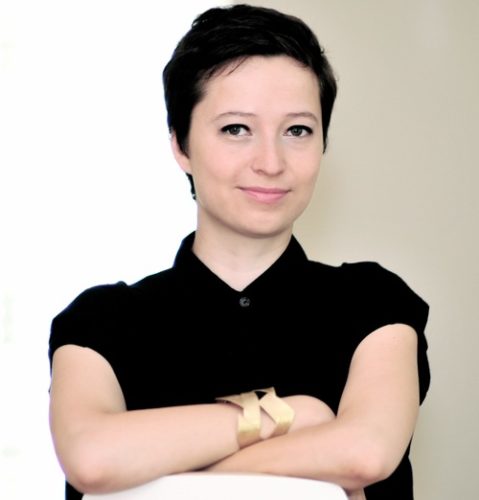TWH — If Emily Dickinson, Anais Nin, Virginia Woolf, and Agatha Christie were Witches, they kept that side of their lives out of history’s spotlight, yet they and 26 other female writers are “initiated” into a coven in the new book Literary Witches: a Celebration of Magical Women Writers by poet-writer Taisia Kitaiskaia and illustrator Katy Horan (Seal Press, October 2017, 128 p.).
Literary Witches is a charming (witchy pun intended) grimoire that weaves biography, recommended readings, Kitaiskaia’s prose poems and Horan’s moody paintings into a heady brew of brief, off-kilter but always evocative portraits of these writers.
Refreshingly pan-cultural, Kitaiskaia romps across space, time, history, ethnicities and genres to anoint the famous (the aforementioned writers as well as Toni Morrison, Sappho, Mary Shelley, and others), plus lesser-known wordsmiths (Iranian poet Farugh Farrokhzad, Laguna Pueblo novelist Leslie Marmon Silko, and more).

The foreword by Pam Grossman is not only engaging and informative itself, it also is essential to this book. Frankly, Literary Witches wouldn’t make much sense and would struggle to bridge women writers and witchery without Grossman’s framing device.
“The word ‘witch’ is thrown around a lot these days: as an insult, an identifier, a badge of honor,” Grossman writes. “We picture a witch, and we picture a multiplicity: she’s a hideous woman in a pointed hat. A sibyl swaying with prophetic visions. A bride of the devil. A devotee to the divine feminine. A Salem villager. An herbalist. A seductress. A forest dweller in a hut made of detritus or chicken legs or candy. A 1990s teenager in pentagrams and plaid. What does the word witch mean, though? And perhaps more importantly: what do we mean when we use it?”
Grossman then answers her own questions: “The Witch is a woman who stands entirely on her own. She is more often than not an outsider, and her gift is transformation. She is a change agent, and her work is sparked by speech: an incantation, a naming, a blessing, a curse.
“Who is more worthy of this moniker than female writers, who themselves conjure worlds out of words? . . . . Let’s recall that many occultic[sic] words are connected to those of language: spelling and spells. Grammar and grimoire. Abracadabra is thought to be derived from an Aramaic phrase that translates to ‘I create like the word.’ To write, then, is to make magic. And so it follows that to be a female writer is, in fact, to be a kind of Witch.”

Illustration of Shirley Jackson [Katy Horan].
The writer’s name is followed by a brief identifying phrase and dates of birth and death – for example “Sappho, lyric poet of ancient Greece, 630-570 B.C.E.”
Then comes Horan’s mood-setting painting of the writer. With a style that recalls the work of Otto Dix and other German expressionist painters, Horan overtly and/or slyly incorporates some of the themes and iconography that Kitaiskaia explores in her ruminations on these literary witches. For example, that black cat stole wrapped around the neck of Harlem Renaissance writer Zora Neale Hurston is there for a reason — as are the ghost, rabbit and devil-imp that dance around her head.
Sometimes Horan’s portraits are subtly creepy, recalling the style of paintings featured in Rod Serling’s “Night Gallery” TV series. For proof, gaze —if you dare — at the penetrating stare of Shirley Jackson, who after all did write “The Haunting of Hill House.”
Horan’s portraits are followed by three stanzas of Kitaiskaia’s poetic invocations (her website identifies her as “a Russian-American poet, writer, and maker with an MFA in Poetry from the James A. Michener Center for Writers”).
Kitaiskaia gives each set of three stanzas a provocative title that often draws on Witchy-Pagan buzzwords: “Sorceress of Islands, Venom, and Histories” reads the one for Antiguan-American author Jamaica Kincaid. “Shaman of Dew, Hummingbirds, and Mushroom Language” reads the title for Mazatec healer and oral poet Maria Sabina.
Kitaiskaia’s stanzas are brief, incantatory prose poems in which she weaves factoids from each writer’s life with her impressions of their personalities, psyches and works.
From her Sylvia Plath entry: “Fury of Motherhood, Marriage, and the Moon. Three Sylvia holograms survive the original Sylvia: The first dismembers male mannequins with ferocious, precise claws. Bees spill from the hollow arms and legs. The bees swarm on to enact Sylvia’s revenge . . . .The Third Sylvia is a shiny black disc, dragging itself from yew to elm, bed to oven . . . .”

Poet-writer Taisia Kitaiskaia [courtesy].
In her Plath follow-up bio, Kitaiskaia notes that the poet “ended her life by putting her head in the oven,” thus informing her earlier “bed to oven” line.
The bio of poet-musician Joy Harjo of the Muscogee (Creek) Nation reveals that her last name means “so brave she’s crazy.”
The Audre Lorde bio entry reads: “Born in NYC to West Indian parents, Audre Lorde proudly proclaimed herself a black lesbian feminist. As an activist and essayist, she was outspoken about racism, sexism, and homophobia. In addition to these themes, her work is populated with mothers, children, sisters, anger, cancer, the erotic, unicorns, snails eating dead snakes, witches, fire, and the importance of refusing silence, period.”
That’s followed by recommended reading that includes the category “Witchiest Poems” and a mention of Lorde’s The Black Unicorn.
Kitaiskaia’s passion shows throughout, but a few times it comes up short. Given Zora Neale Hurston’s firsthand explorations of voodoo and hoodoo in Haiti, Jamaica and New Orleans, one might hope that her profile would be, well, one of the “witchiest” in the book. While Horan’s Zora painting would look right at home in Marie Laveau’s parlor, Kitaiskaia’s prose poem stanzas fail to weave much of a spell here.
It’s only in the bio segment that we are told Hurston was “initiated into Vodou, once by boiling a live black cat and passing its bones over her lips, and took the first known photograph of a zombie.” (For Hurston’s account of the “black cat bone” ritual, see her collection of folk and hoodoo tales, “Mules and Men.”)

Illustration of Zora Neale Hurston [Katy Horan].
Anyone seeking to use Literary Witches and its brief, sometimes cryptic entries as some sort of Cliff Notes to help with a literature class theme paper will be sorely disappointed. Indeed, readers are advised to keep Google and Wikipedia nearby and on the alert, ready to fill in the blanks of these sometimes frustratingly sketchy profiles — Kitaiskaia is, after all, a poet and not a literary historian.
Still, Literary Witches is a clever, fun, tantalizing and thought-provoking glimpse of great writers who have brought magic into the world. Rather than being a purely informative work, it’s a “mood” book — one that seeks and succeeds in binding a witchy aesthetic and spirit to literary history.
The Wild Hunt is not responsible for links to external content.
To join a conversation on this post:
Visit our The Wild Hunt subreddit! Point your favorite browser to https://www.reddit.com/r/The_Wild_Hunt_News/, then click “JOIN”. Make sure to click the bell, too, to be notified of new articles posted to our subreddit.